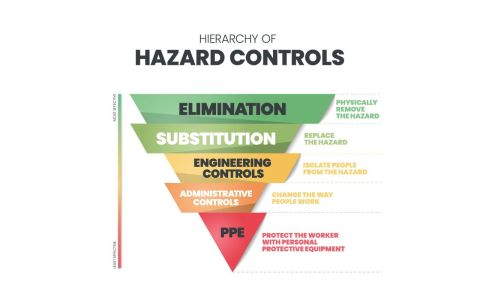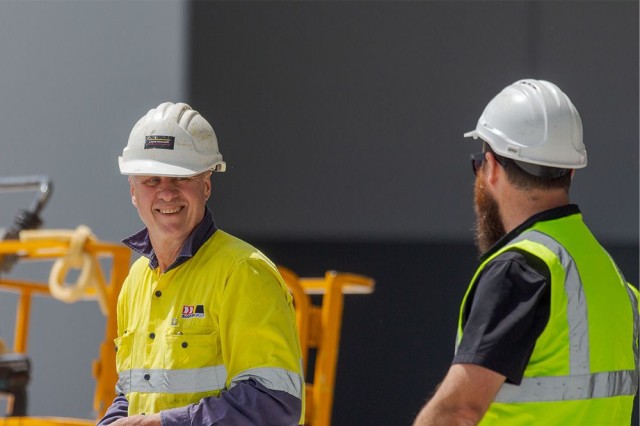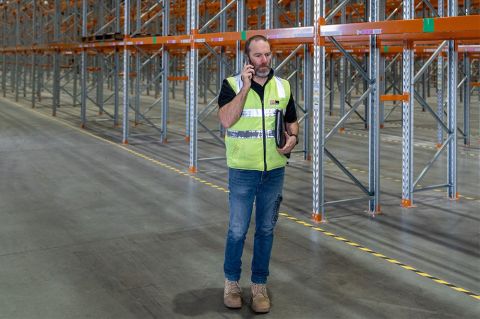Hierarchy of Control Explained: 5 Steps to a Safer, Smarter Workplace
Let's analyze the Hierarchy of Control and how it merges workplace safety with risk management, aiming to eliminate and reduce risks in the workplace.
The Hierarchy of Control involves a step-by-step approach to creating effective control measures to protect employees and create safer work environments.
This system improves work health and safety, providing a roadmap for employers to safeguard their workers by mitigating workplace hazards.
This article explains what the Hierarchy of Control is, why it is an important system for workplaces to follow as an important part of your overall occupational health and safety strategy, and how Barrier Group can help you implement risk control measures in your workplace.
What is the Hierarchy of Control?
The Hierarchy of Control boosts efficient control methods in work environments by using a systematic process to eliminate and minimize hazards. It categorises risk controls from the most protective and dependable level down to the least protective and least reliable level.
This system efficiently aids in promoting health and safety in the workplace, cultivating an environment where employees feel safe and healthy and, crucially, return to their loved ones after a day's work.
In the Hierarchy of Control, in some cases, a combination of these controls is often required.
Overview of the Hierarchy of Control
The structure of the hierarchy of control, from the most to least effective, includes:
- Eliminate hazards and risks - This is the highest level of safeguarding and the most efficient way of managing risks. Eliminating the danger and the risk it poses is the most effective preventative measure.
- Substitute the risk - This stage mitigates risks by replacing the hazard.
- Engineering controls – Isolates people from the hazard.
- Administrative controls - A lower level of control and less reliable, this level involves administrative measures to change the way people work by lessening their exposure to hazards and reducing their level of harm.
- Personal protective equipment (PPE) – The least effective level of safety and the least dependable measure. This level utilises personal protective equipment (PPE) to shield and protect workers from potential harm.
Why is the Hierarchy of Control important for workplace safety?
The Hierarchy of Control can produce effective controls and enhance work health and safety.
This model allows companies and organisations to focus their energy and resources on introducing the most crucial and efficient safety precautions first.
It improves safety in the workplace and aids these workplaces by guaranteeing compliance with Australian safety standards and regulatory obligations, fostering a proactive approach to risk management.
The Hierarchy of Control, thus, methodically tackles risk management and worker protection, starting with the most essential solution of elimination through to the application of Personal Protective Equipment (PPE).
Employer duties
It is the role of workplaces and employers to create safe work environments and reduce hazards to health and safety under the Occupational Health and Safety Act 2004 (OHS Act).
Although it's not feasible to eliminate all hazards, it is the responsibility of workplaces to minimize these risks where it is reasonably possible.
The hierarchy of controls supports employers in fulfilling their legal responsibilities the fulfill the OHS Act 2004.
Such laws and regulations are designed to foster an environment, skills, and practices that allow the employee and their institution to perform their tasks effectively and in a manner that prevents occurrences that could lead to harm.
Mitigating the hazards and removing potential threats in the workplace may involve the use of one risk management strategy or a blend of multiple strategies, depending on the situation.
What is "reasonably practical?"
An employer must handle WHS risks whenever reasonably practical. As per Safe Work Australia, contemplate the pertinent issues that should be taken into account to determine when a safety issue is reasonably practical.
This includes considering:
- The likelihood of the hazard or risk
- The harm that may occur
- Knowledge of the hazard or risk
- Ways to minimise or eliminate the risk, and if these are available and suitable
- cost, including whether the cost is grossly disproportionate to the risk.
How to use the Hierarchy of Control
1. Eliminate the risk
The most effective step in the Hierarchy of Control involves completely removing the hazard from the workplace.
This method is the ideal solution because it ensures that workers are no longer exposed to the risk, whether this is a change in:
- processes
- materials,
- or tasks.
For example, a business may have to eliminate the use of hazardous substances or substitute tasks that require working at elevated levels with operations conducted at ground level.
However, while elimination is the preferred method of hazard control, it can be costly to implement, especially in established systems.
Nevertheless, where possible, addressing risks at a project's design or planning stage is often the most cost-effective and safest solution in the long run.
Barrier Group, an award-winning safety solutions provider, can help you improve safety in your workplace. We offer a wide range of safety products and solutions, from simple to complex. Check out Barrier Group's On-Site Assessments today!
2. Substitution
Substitution is the second most effective control in the hierarchy of control.
In many cases, eliminating workplace safety hazards may not be practical; in this case, the second-best option is to replace hazardous material or process with a less dangerous alternative.
This step in the hierarchy of control lowers the risk to workers. It does this by using safer methods or substances. However, it does not completely remove the hazard.
Before substituting a hazard, several key questions should be considered to ensure the substitution improves health and safety without the risk of creating new hazards.
- Is the substitution safer? What are the potential hazards of the substitution itself?
- Will the substitution impact work processes that would negatively affect productivity and work quality?
- Are there any new hazards introduced by the substitute?
- Are workers trained to handle the substitute safely? Would additional training or safety protocols be required?
One example is replacing a toxic solvent-based paint with a safer, water-based option. Another is using a cordless drill instead of a corded one to lower the risk of electrocution.
A thorough assessment guarantees that the replacement enhances safety without introducing unintended risks.
3. Engineering Controls
Physical changes to machinery, systems, or the environment. Engineering controls are more effective because they isolate the workers from the hazard. They include implementing physical modifications to the workplace.
An example of engineering controls could be installing guardrails around holes or elevated platforms to isolate employees from potential harm or using remote controls to operate machinery.
Other examples of engineering controls include mechanical devices to assist with manual handling of heavy loads, machinery guarding and interlocking systems on gates around automated equipment and machinery, speed-governing mechanisms, and pedestrian-sensing systems.
If you work in an environment with automated machinery and systems, consider Barrier Group's range of machinery guarding and warehouse partitioning systems as an engineering control measure for potential hazards. Barrier Groups machinery guarding range is designed to effectively separate pedestrians, machinery, and vehicles—including forklifts—and provide a robust physical barrier that shields warehouse and factory workers from potentially hazardous equipment and automated machinery.
4. Administrative controls
This is the level in the hierarchy of control, administrative controls (or strategies) are implemented to decrease a worker's exposure to risks by modifying the way work is conducted, rather than eliminating the risk itself.
Often this process involves creating safer procedures, policies, and practices to minimise risks.
Examples of administrative controls being implemented in the work environments include:
- Establishing formal safety guidelines
- Using job rotation or breaks to limit worker exposure
- The implementation of warning signs and alarms
- Comprehensive safety training
If you are a business or employer using administrative controls for safety, they can be useful.
However, they are not as reliable as higher-level controls like elimination or substitution.
5. Personal Protective Equipment (PPE)
Personal Protective Equipment (PPE) is the last line of defense in the hierarchy of control. It is also considered as the least effective way of controlling risks and protecting workers.
Personal Protective Equipment (PPE) is seen as the least effective way to control hazards. This is because it depends on workers using the PPE correctly.
Personal Protective Equipment (PPE) can include items such as:
- Helmets
- Gloves
- Safety Glasses
- Face Shields,
- And Protective Clothing
These pieces of Personal Protective Equipment are made to keep workers safe from many hazardous and potential workplace dangers.
Top Tip: Personal Protective Equipment (PPE) is typically used alongside other methods of the hierarchy of control and is considered a temporary or supplementary safety measure. It should be considered as a last resort where no other safety measure is practical.
How to implement the Hierarchy of Controls in your workplace
Applying the hierarchy of control in the workplace requires a systematic approach to reduce hazards, and the comprehensive suite of safety solutions from Barrier Group can significantly contribute to this process.
- Eliminate - Firstly, employees should assess whether hazards can be eliminated. This may include removing dangerous equipment or redesigning workflows.
- Substitute - The next step to consider in the Hierarchy of Controls, is where Barrier Group's safer alternatives, like hand and guardrails, can replace high-risk solutions.
- Administrative Controls - Can enhance worker safety through training programs and safety protocols that detail the use of these solutions.
- Personal Protective Equipment (PPE) - The last resort or interim measure to reduce or control risks, PPE like high-visibility clothing and safety helmets, when used properly, provide an additional layer of protection.
Integrating Barrier Group's offerings with the Hierarchy of Control forms a thorough safety plan that emphasises employee health and reduces occupational risks.
Final word
As you can see, the hierarchy of control is a valuable framework for managing workplace safety and minimising risks to employees.
By following the step-by-step approach of the Hierarchy of Controls, businesses can eliminate hazards.
This helps protect workers and ensures compliance with Australian Safety Standards.
Barrier Group is an expert in safety solutions for businesses in Australia and New Zealand, offering solutions that meet every level of the hierarchy of control.
Check our range of handrail and guardrail products and contact the team to organise a free on-site assessment of your workplace to keep your business and employees safe and secure from workplace hazards.




